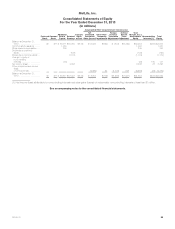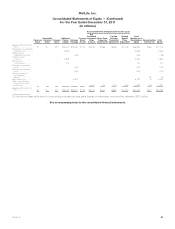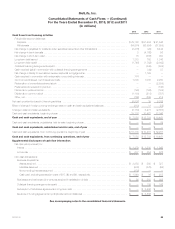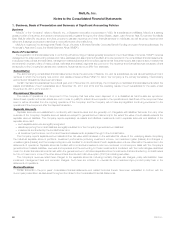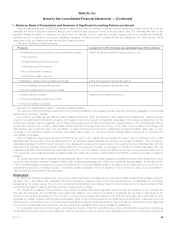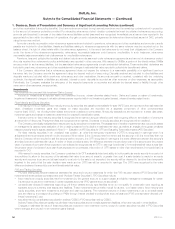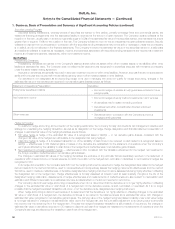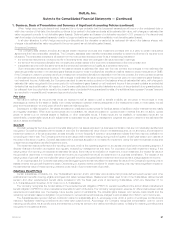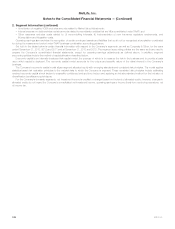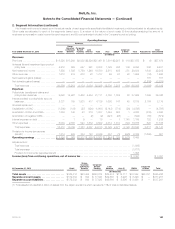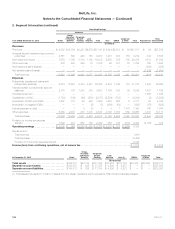MetLife 2013 Annual Report Download - page 103
Download and view the complete annual report
Please find page 103 of the 2013 MetLife annual report below. You can navigate through the pages in the report by either clicking on the pages listed below, or by using the keyword search tool below to find specific information within the annual report.
MetLife, Inc.
Notes to the Consolidated Financial Statements — (Continued)
1. Business, Basis of Presentation and Summary of Significant Accounting Policies (continued)
Mortgage Loans
The Company disaggregates its mortgage loan investments into three portfolio segments: commercial, agricultural, and residential. The
accounting policies that are applicable to all portfolio segments are presented below and the accounting policies related to each of the portfolio
segments are included in Note 8.
Mortgage Loans Held-For-Investment
Mortgage loans held-for-investment are stated at unpaid principal balance, adjusted for any unamortized premium or discount, deferred fees or
expenses, and are net of valuation allowances. Interest income and prepayment fees are recognized when earned. Interest income is recognized
using an effective yield method giving effect to amortization of premiums and accretion of discounts.
Also included in mortgage loans held-for-investment are commercial mortgage loans held by CSEs and residential mortgage loans for which the
FVO was elected. These mortgage loans are stated at estimated fair value. Changes in estimated fair value are recognized in net investment
gains (losses) for commercial mortgage loans held by CSEs — FVO, and net investment income for residential mortgage loans.
Mortgage Loans Held-For-Sale
Mortgage loans held-for-sale that were previously designated as held-for-investment, but now are designated as held-for-sale and mortgage loans
originated with the intent to sell for which FVO was not elected, are stated at the lower of amortized cost or estimated fair value.
Policy Loans
Policy loans are stated at unpaid principal balances. Interest income on such loans is recorded as earned using the contractual interest rate.
Generally, accrued interest is capitalized on the policy’s anniversary date. Valuation allowances are not established for policy loans, as they are fully
collateralized by the cash surrender value of the underlying insurance policies. Any unpaid principal or interest on the loan is deducted from the cash
surrender value or the death benefit prior to settlement of the insurance policy.
Real Estate
Real estate held-for-investment is stated at cost less accumulated depreciation. Depreciation is provided on a straight-line basis over the
estimated useful life of the asset (typically 20 to 55 years). Rental income associated with such real estate is recognized on a straight-line basis over
the term of the respective leases. The Company periodically reviews its real estate held-for-investment for impairment and tests for recoverability
whenever events or changes in circumstances indicate the carrying value may not be recoverable and exceeds its estimated fair value. Properties
whose carrying values are greater than their undiscounted cash flows are written down to their estimated fair value, which is generally computed using
the present value of expected future cash flows discounted at a rate commensurate with the underlying risks.
Real estate for which the Company commits to a plan to sell within one year and actively markets in its current condition for a reasonable price in
comparison to its estimated fair value is classified as held-for-sale. Real estate held-for-sale is stated at the lower of depreciated cost or estimated fair
value less expected disposition costs and is not depreciated.
Real Estate Joint Ventures and Other Limited Partnership Interests
The Company uses the equity method of accounting for investments in equity securities when it has significant influence or at least 20% interest
and for investments in real estate joint ventures and other limited partnership interests (“investees”) when it has more than a minor ownership interest
or more than a minor influence over the investee’s operations, but does not have a controlling financial interest. The Company generally recognizes its
share of the investee’s earnings on a three-month lag in instances where the investee’s financial information is not sufficiently timely or when the
investee’s reporting period differs from the Company’s reporting period.
The Company uses the cost method of accounting for investments in which it has virtually no influence over the investee’s operations. The
Company recognizes distributions on cost method investments as earned or received. Because of the nature and structure of these cost method
investments, they do not meet the characteristics of an equity security in accordance with applicable accounting standards.
The Company routinely evaluates its equity method and cost method investments for impairment. For equity method investees, the Company
considers financial and other information provided by the investee, other known information and inherent risks in the underlying investments, as well
as future capital commitments, in determining whether an impairment has occurred. The Company considers its cost method investments for
impairment when the carrying value of such investments exceeds the net asset value (“NAV”). The Company takes into consideration the severity and
duration of this excess when determining whether the cost method investment is impaired.
Short-term Investments
Short-term investments include securities and other investments with remaining maturities of one year or less, but greater than three months, at
the time of purchase and are stated at estimated fair value or amortized cost, which approximates estimated fair value.
Other Invested Assets
Other invested assets consist principally of the following:
‰Freestanding derivatives with positive estimated fair values are described in “— Derivatives” below.
‰Tax credit and renewable energy partnerships derive a significant source of investment return in the form of income tax credits or other tax
incentives. Where tax credits are guaranteed by a creditworthy third party, the investment is accounted for under the effective yield method.
Otherwise, the investment is accounted for under the equity method.
‰Leveraged leases are recorded net of non-recourse debt. Income on leveraged leases is recognized by applying the leveraged lease’s estimated
rate of return to the net investment in the lease. The Company regularly reviews residual values for impairment.
‰Funds withheld represent a receivable for amounts contractually withheld by ceding companies in accordance with reinsurance agreements. The
Company recognizes interest on funds withheld at rates defined by the terms of the agreement which may be contractually specified or directly
related to the underlying investments.
‰Investments in joint ventures that engage in insurance underwriting activities are accounted for under the equity method.
MetLife, Inc. 95


